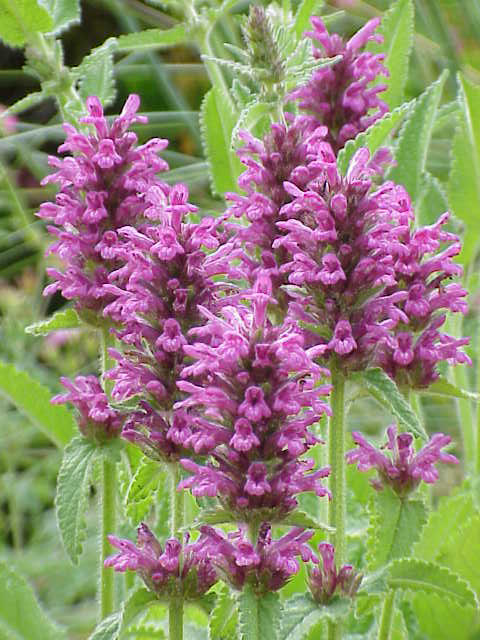- Stachys
Taxobox
name = "Stachys"

image_width = 240px
image_caption = "Stachys monnieri"
regnum =Plant ae
divisio = Magnoliophyta
classis =Magnoliopsida
ordo =Lamiales
familia =Lamiaceae
genus = "Stachys"
subdivision_ranks =Species
subdivision = About 300; see text"Stachys" is a
genus of about 300 species of annual and perennialherb aceous plants andshrub s in the familyLamiaceae . The distribution of the genus coversEurope ,Asia ,Africa ,Australasia andNorth America . Common names include Heal-all, self-heal, woundwort, betony, lamb's ears, and hedgenettle.The stems vary from 50-300 cm tall, with simple, opposite triangular leaves 1-14 cm long with serrated margins; in most species the leaves are softly hairy. The
flower s are 1.2 cm long, clustered in the axils of the leaves on the upper part of the stem, the corolla 5-lobed with the top lobe forming a 'hood', varying from white to pink, purple, red or pale yellow."Stachys" species are used as food plants by the
larva e of someLepidoptera species including the "Coleophora " case-bearers "C. auricella" (recorded on "S. officinalis"), "C. lineolea" and "C. wockeella" (feeds exclusively on "S. officinalis").Habitat
In Europe, "stachys" can be found growing in wastelands, grasslands and woodland edges. All-heal thrives in any damp soil in full sun or in light shade. Plants are apt to become troublesome weeds in turf that is at all damp. Sow seed in very early spring in a flat outdoors, or give a short cold and moist conditioning treatment before sowing in a warm place. Growing from 1 to 2 feet high, with creeping, self-rooting, tough, square, reddish stems branching at leaf axis. The leaves are lance shaped, serrated and reddish at tip, about an inch long and 1/2 inch broad, grow on short stalks in opposite pairs down the square stem. The flowers grow from a clublike, somewhat square, whirled cluster, immediately below this club are a pair of stalkless leaves standing out on either side like a collar. Flowers are two lipped and tubular, the top lip is a purple hood, and the bottom lip is often white, it has three lobes with the middle lobe being larger and fringed upwardly. Flowers bloom at different times depending on climate and other conditions. Mostly from June to August. Gather whole plant when flowers bloom, dry for later herb use. Leaves and small flowers are edible.
Properties
Used as a medicine for centuries on just about every continent in the world, for a wide variety of ailments, Heal-All has been viewed by herbalists as something of a panacea. It does however have some medicinal uses that are constant. The plants most useful constituents are
Betulinic acid , D-Camphor, Delphinidin, Hyperoside, Manganese,Oleanolic acid ,Rosmarinic acid , Rutin,Ursolic acid , and Tannins. The whole plant is medicinal as alterative, antibacterial, antipyretic, antiseptic, antispasmodic, astringent, carminative, diuretic, febrifuge, hypotensive, stomachic, styptic, tonic, vermifuge and vulnerary. A cold water infusion of the freshly chopped or dried and powdered leaves is a very tasty and refreshing beverage, weak infusion of the plant is an excellent medicinal eye wash for sties and pinkeye. It is taken internally as a medicinal tea in the treatment of fevers, diarrhoea, sore mouth and throat, internal bleeding, and weaknesses of the liver and heart.The Chinese artichoke ("S. affinis"), is grown for its edible
tuber .Woolly Betony ("S. byzantina") is a popular decorative garden plant.
The name woundwort derives from its past use in herbal medicine for the treatment of wounds.
Selected species
Trivia
"
General Woundwort ", named after the plant, is arabbit in the novel "Watership Down " by Richard Adams.Robert Frost references the plant in his poem "Design."References
Some of this is found in "Lippert, W. & Podlech, D. 'WIldflowers of Britain & Europe'. Collins Nature Guides 1994.
Wikimedia Foundation. 2010.
